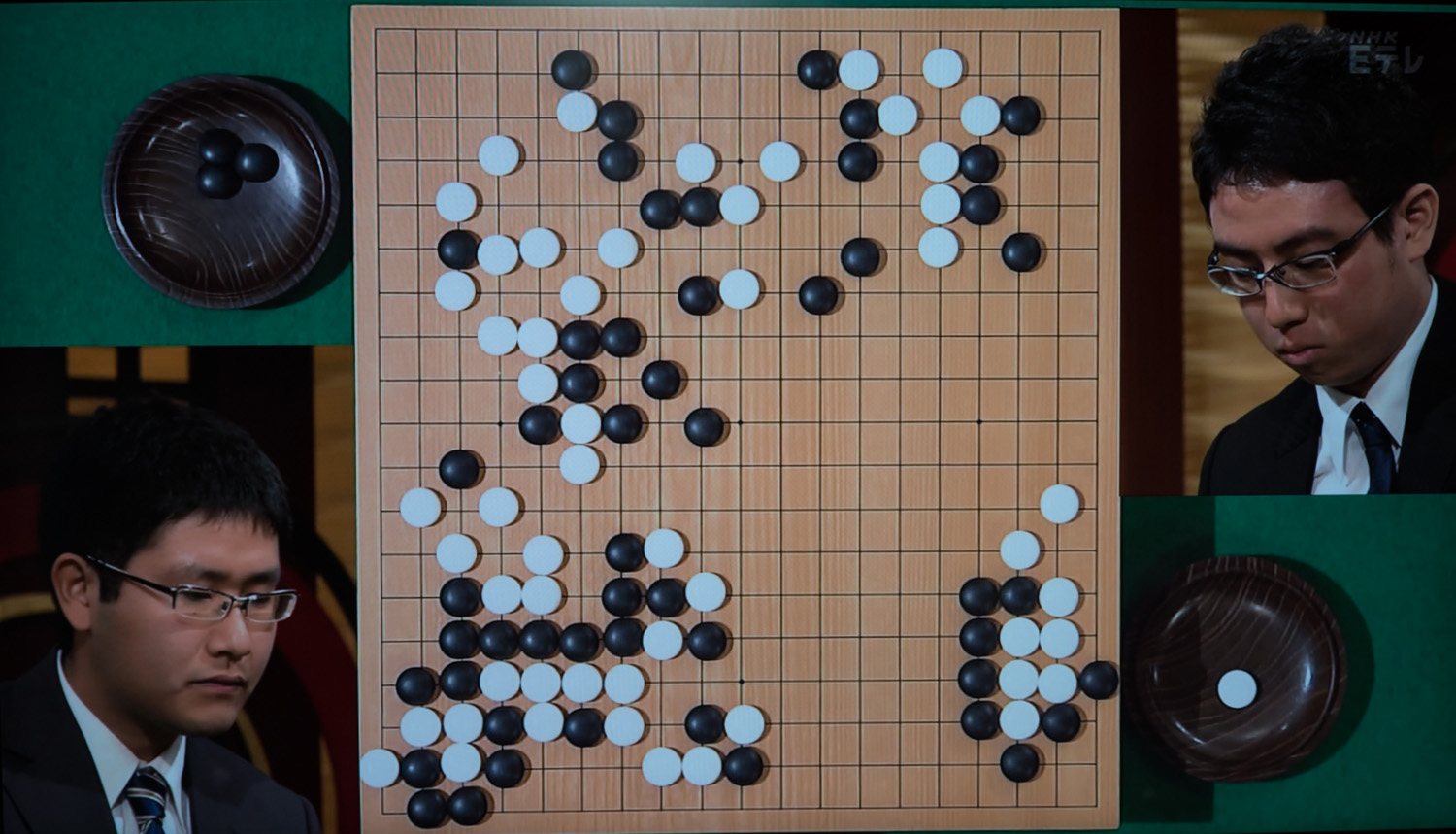 本日のNHK杯戦の囲碁は黒番が寺山怜5段、白番が一力遼8段です。二人もNHK杯戦で準優勝しています。(一力8段は2回。)布石では白が右上隅でかかり一本を打った後、右下隅で三々に入りといった最近もはや当たり前となった進行です。黒は左下隅で両ガカリしていきましたが、白は右上隅でのかかり一本が効いて、黒一子をシチョウに取ることが出来ました。黒はそのシチョウ当たりをにらみながら、左上隅の白の小ゲイマに肩を突いていきました。その後黒は左辺に展開し、シチョウで黒一子を抜いた白への攻めを伺いました。その後白が左下隅の黒に切りをいれ様子を伺ったのに黒は反発し、結果として下辺と左辺の白が切断されました。しかしその過程で白は左辺黒への覗きを打ち、これに対し黒が継がなかったので、結局白は左辺を大きく地にしました。その替わり下辺の白は薄くなりましたが、左下隅への利きが2つあり、死ぬことはありませんでした。黒は下辺の白に効かしにいきましたが途中で手を抜いて中央でポン抜いて白に左辺で手を入れるように迫りました。ここで白が手を抜いて、下辺で黒に切りを入れたのが機敏で、左辺はアジは悪いですが何とか保っていました。そのによって地合は白が大きくリードしたため、黒は上辺の白(2カ所)を攻めながら中央をまとめるしかなくなりました。白はまず右上隅にかかった白の一団の活きを図り、ほぼOKになりました。その後更に上辺左の白も担ぎ出しました。黒がこの白の一団に迫っていった時、白の返し技が炸裂し、包囲している黒を分断し、上辺の黒を取り込みました。黒は白の尻尾をちぎりましたが、中央の黒地を完璧にまとめてもどうか、という差になりました。その後下辺で劫が発生しましたが、黒からみて一手ヨセコウであり、白は劫は譲って手堅く活きました。最後に黒が左辺でサガリを利かそうとしたのに白は中央の手で応え、結果として後で中央に飛び出す手が出来ました。黒はダメヅマリのためこの白を切り離しに行けず、ここで黒の投了となりました。
本日のNHK杯戦の囲碁は黒番が寺山怜5段、白番が一力遼8段です。二人もNHK杯戦で準優勝しています。(一力8段は2回。)布石では白が右上隅でかかり一本を打った後、右下隅で三々に入りといった最近もはや当たり前となった進行です。黒は左下隅で両ガカリしていきましたが、白は右上隅でのかかり一本が効いて、黒一子をシチョウに取ることが出来ました。黒はそのシチョウ当たりをにらみながら、左上隅の白の小ゲイマに肩を突いていきました。その後黒は左辺に展開し、シチョウで黒一子を抜いた白への攻めを伺いました。その後白が左下隅の黒に切りをいれ様子を伺ったのに黒は反発し、結果として下辺と左辺の白が切断されました。しかしその過程で白は左辺黒への覗きを打ち、これに対し黒が継がなかったので、結局白は左辺を大きく地にしました。その替わり下辺の白は薄くなりましたが、左下隅への利きが2つあり、死ぬことはありませんでした。黒は下辺の白に効かしにいきましたが途中で手を抜いて中央でポン抜いて白に左辺で手を入れるように迫りました。ここで白が手を抜いて、下辺で黒に切りを入れたのが機敏で、左辺はアジは悪いですが何とか保っていました。そのによって地合は白が大きくリードしたため、黒は上辺の白(2カ所)を攻めながら中央をまとめるしかなくなりました。白はまず右上隅にかかった白の一団の活きを図り、ほぼOKになりました。その後更に上辺左の白も担ぎ出しました。黒がこの白の一団に迫っていった時、白の返し技が炸裂し、包囲している黒を分断し、上辺の黒を取り込みました。黒は白の尻尾をちぎりましたが、中央の黒地を完璧にまとめてもどうか、という差になりました。その後下辺で劫が発生しましたが、黒からみて一手ヨセコウであり、白は劫は譲って手堅く活きました。最後に黒が左辺でサガリを利かそうとしたのに白は中央の手で応え、結果として後で中央に飛び出す手が出来ました。黒はダメヅマリのためこの白を切り離しに行けず、ここで黒の投了となりました。
日: 2018年12月2日
Japanese cuisine and kitchen knives
The following is my essay that I wrote as an assignment for an English school in Japan:
Topic: Japanese cuisine and kitchen knives
Style: Free writing
Washoku, traditional dietary cultures of the Japanese are now quite famous worldwide, and UNESCO added them to their list of the Intangible Cultural Heritage in 2013.
One of the most important factors that supports this sophisticated culture is wide variety and long tradition of Japanese kitchen knives. If you think of Japanese dishes, you might be reminded of sushi or sashimi. Both dishes use raw fish. Some people may think the latter one is quite easy to prepare since it is just a dish with cut raw fish pieces. Yes, it is just cutting fish, but what is important is how you cut it. If you cut raw fish with a normal kitchen knife, the cells of fish meat will surely be crushed, and you cannot get cut pieces of fish with sharp edges. It is alleged that bad way of cutting diminishes the taste of sashimi quite a lot. All Japanese skilled chefs use very thin and long special knives specially dedicated to sashimi. They cut fish meat utilizing the whole length of a knife and cut it by drawing the knife quickly because the edge degree will be minimized and it will enable better cutting.
In order to keep sharp edges, it is vital to sharpen them before you use them. In western countries, chefs use a grinding bar to sharpen knives. Japan has a long tradition of Japanese swords and sharpening skill has reached at the highest level in the whole world. Japanese blacksmiths and chefs use several different grinding stones to sharpen Japanese swords and kitchen knives. The stones are usually flat stones with sizes usually around 7 X 30 X 3 cm. They start to grind swords or knives by rather harsh stones, and gradually change to stones with finer surfaces. Most grinding stones now in Japan are made artificially, but some good chefs stick to natural stones. A good natural grinding stone costs sometimes more than $1,000. Some say that each good knife has an ideal grinding stone as a pair, and they do not spare money to find it.
Another interesting thing about Japanese knives is that many of them are single-edged while most western knives are double-edged. It is said that single-edged is better in cutting but is difficult to cut something straight. There are also big differences in the way we sharpen single-edged knives compared to sharpen double-edged ones by grinding stones. Good chefs in Japan usually sharpen their knives by themselves, but there are also many of those who leave it to some professionals.
